Brands are saying “check mate” to the disappearance of third spaces by creating new places for their communities to connect in person via fitness and wellness activations.
These brand-driven communities are not just about physical activity; they’re about facilitating social experiences that feed humans’ craving for authenticity, meaningful relationships, sense of belonging, and shared purpose. While various types of physical events can support community building, fitness and wellness experiences stand out as the most potent catalyst for generating genuine brand loyalty, reshaping social interaction, and driving stronger connections as evidenced by the impact of fitness-focused brand communities.
What is “Community” in 2025?
The term “community” is due for an upgrade. The formative concept was significantly tied to geographical proximity, mutual interest, cultural heritage, shared governance, religious beliefs, and natural resources. Universally, these early communities were characterized by strong social bonds, face-to-face interactions, and deep commitment to their values.
What powered the unification of people into communities was a primal need for self-reliance and autonomy, crucial for survival. Groups of people that did not sustain a healthy relationship with local resources did not last long.
After nearly a quarter of the 21st century, community is defined much differently, thanks in large part to technology. People now experience digital-physical hybrid communities as a result of seamless integrated online and offline experiences, technology-enabled real-time interactions, and global connectivity that transcends geographical locations.
Here are the defining aspects of community in 2025:
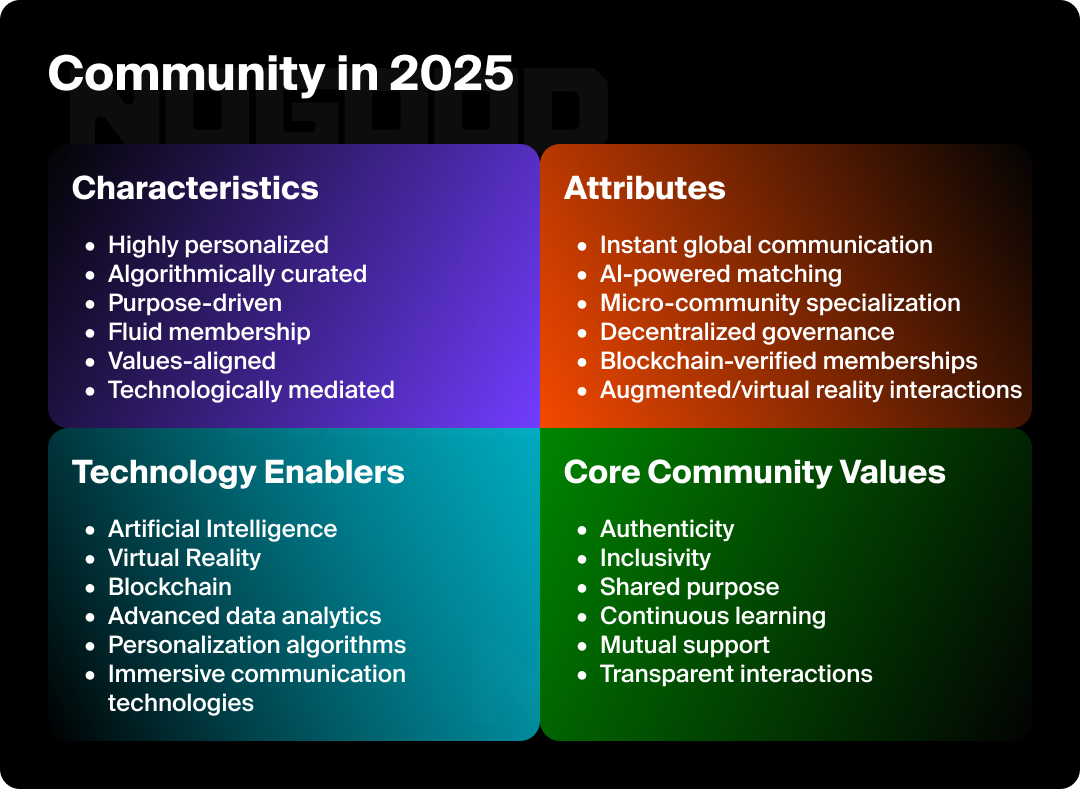
In the last decade, brands have leaned heavily into how technology can be a driving force in creating modern-day communities. Online platforms became the primary medium for building and sustaining connections, replacing in-person interactions. Social media and other digital platforms dominated communal experience.
In 2024, 76% of internet users actively participated in online communities, signaling a significant shift towards digital. This trend is primarily driven by the unparalleled convenience and global connectivity that digital spaces offer, enabling instant, borderless communication and community engagement.
However, the pendulum is swinging back. Despite the convenience of digital platforms, people are recognizing the irreplaceable value of in-person connections. These recent trends are manifesting in modern dating as well, with a growing desire for authentic, face-to-face relationships.
A 2024 survey revealed that 73% of singles expressed a strong preference for meeting potential partners in person rather than online. This shift is further evidenced by the rising popularity of in-person dating events, which offer a blend of first-date-like conversations and bar-like mingling, allowing attendees to form deeper connections while easily transitioning between interactions.
As people increasingly recognize that virtual interactions alone cannot fully satisfy our innate need for physical human connection, this trend has significant implications. So why is this shift important for brands in 2025?
The Power of Physical Brand Communities
Today’s top-leading brands understand the multi-dimensional perspective of community needed to stand out in the marketplace and impact culture. This shift has compelled them to elevate their community-driven strategies by launching physical, in-person activations.
By creating tangible experiences, brands are able to 1) transform potential and current customers into loyal community members via anatomical benefits; 2) tap into the psychology of social identity; 3) and nurture authentic relationships that digital platforms only scratch the surface of.
First, here are some unique anatomical benefits of physical brand communities:
- Sensory Engagement: According to a study by VML Intelligence, 63% of consumers crave multisensory brand experiences, and 72% desire new experiences that engage as many of their senses as possible. Physical experiences activate multiple senses simultaneously, creating more vivid and memorable interactions. When it’s real, it sticks.
- Oxytocin Release: Face-to-face interactions trigger the release of oxytocin, often called the “cuddle hormone” and “morale molecule,” which promotes trust and social bonding. Studies indicate that oxytocin levels can increase by 47% during in-person social interactions.
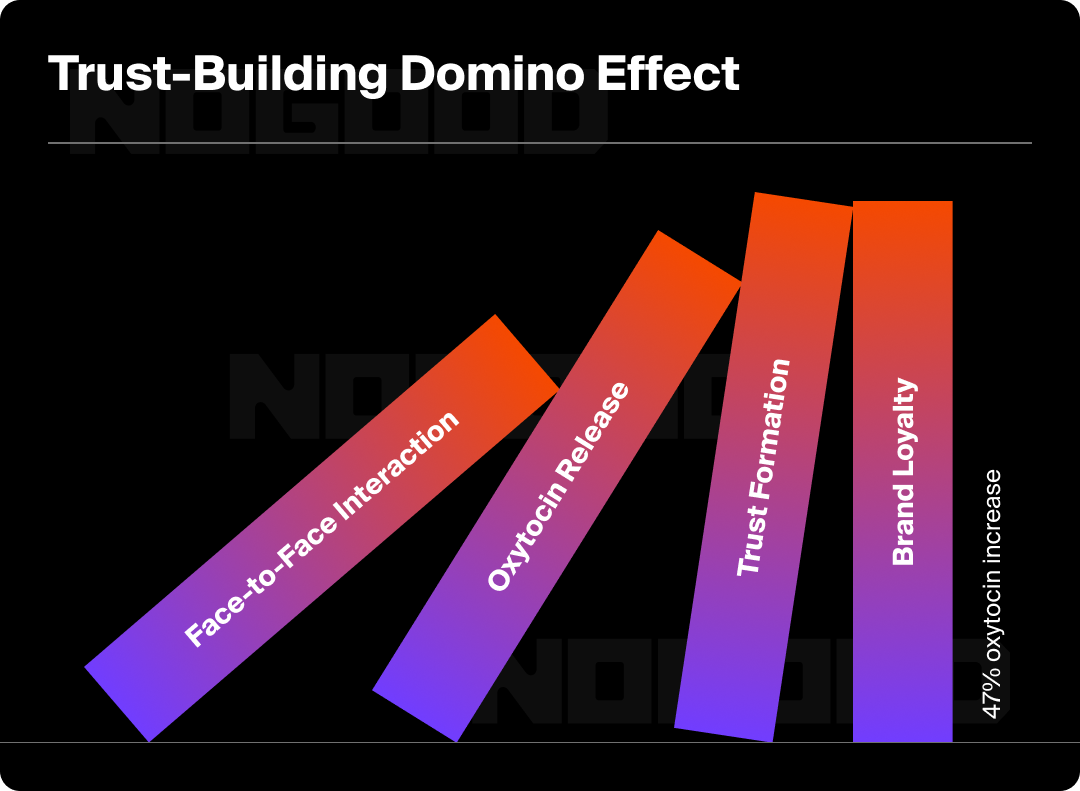
When consumers develop a profound anatomical and emotional response from brand-driven experiences, they’re significantly more likely to internalize them as a component of their personal identity. How people view themselves is powerful, and brands need to tap in. Understanding the psychology behind the internalization is a crucial factor in the power behind a brand’s decision to build a physical community.
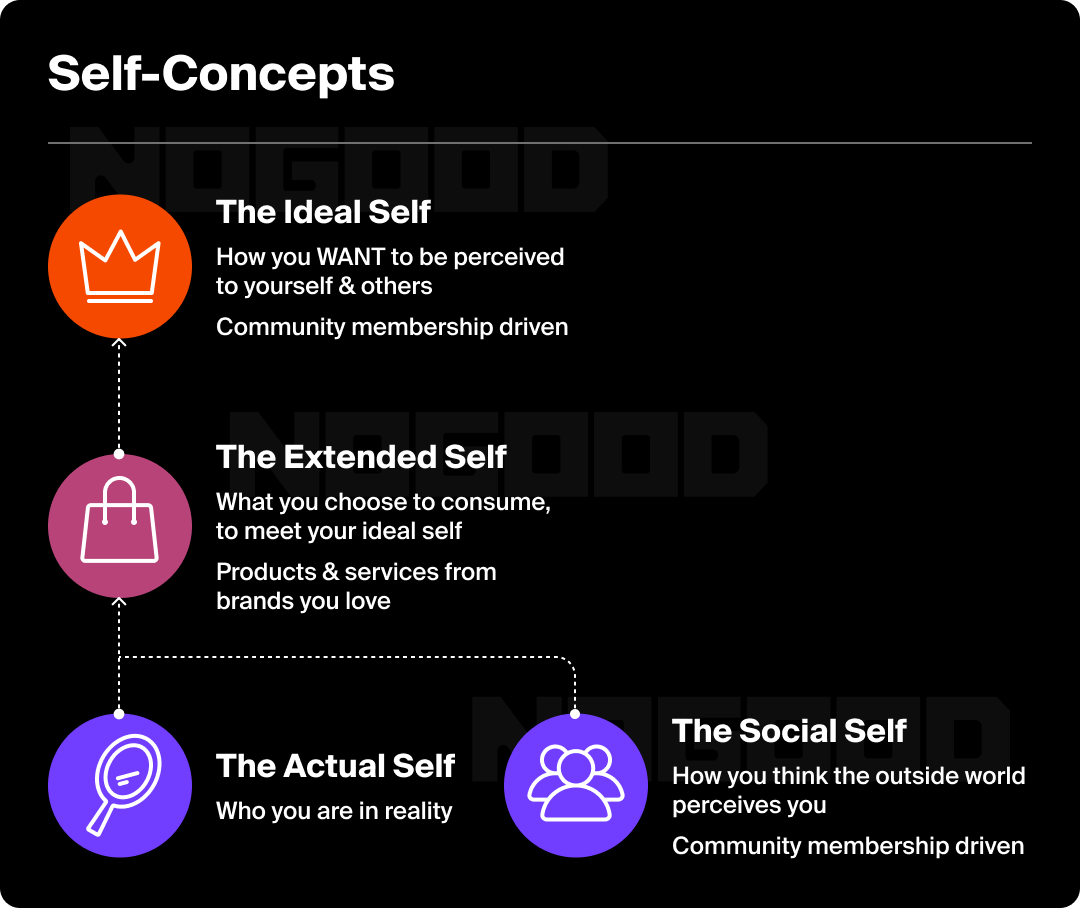
Social identity in community is built on categorization, shaping self-perception through shared values and norms. This involves both emotional and functional connections, often strengthened by comparing the “in-group” to others, boosting self-esteem and solidifying long-term membership. Ultimately, once brand-driven communities have locked themselves into some fraction of people’s identities, they’re one massive step closer to creating a loyal customer base that not only makes repeated purchases but becomes brand advocates.
This identity-centric consumption manifests in various ways: consumers make purchases that align with their self-concept, use products to extend their identity, balance group affiliation with individuality, and prefer brands that match their self-image. They also use purchases to facilitate identity transformations, express values, support personal narratives, and communicate their identity to others. These patterns underscore how deeply intertwined consumer behavior is with self-perception and social identity.
By leveraging the principles of social identity theory and tapping into the innate human desire for connection, brands are fostering stronger emotional bonds with their customers and cultivating a thriving, engaged community that extends far beyond mere transactions.
The final benefit of brands facilitating tangible experiences is authenticity. This word has been a huge buzzword after the last few years, but are brands really fulfilling the concept? Brands with physical communities are on the right path.
Brand-created physical communities and experiences are playing a crucial role in creating true brand authenticity and helping individuals make authentic connections with others. These interactions provide a tangible dimension to brand values, allowing customers to experience and embody the brand’s mission in real life.
The Health Meta
We’re in a new Zeitgeist, defined significantly by the health meta. What is it? Why is it important to brand evolution? Why should brands outside of the fitness/wellness space consider leaning in?
The health meta is a holistic and integrative approach to understanding health and wellness that goes beyond traditional medical models. Principles of this concept include the mind-body connection, biological intelligence, root-cause diagnosis, neuroscience understanding, personalized approaches, and holistic well-being and empowerment.
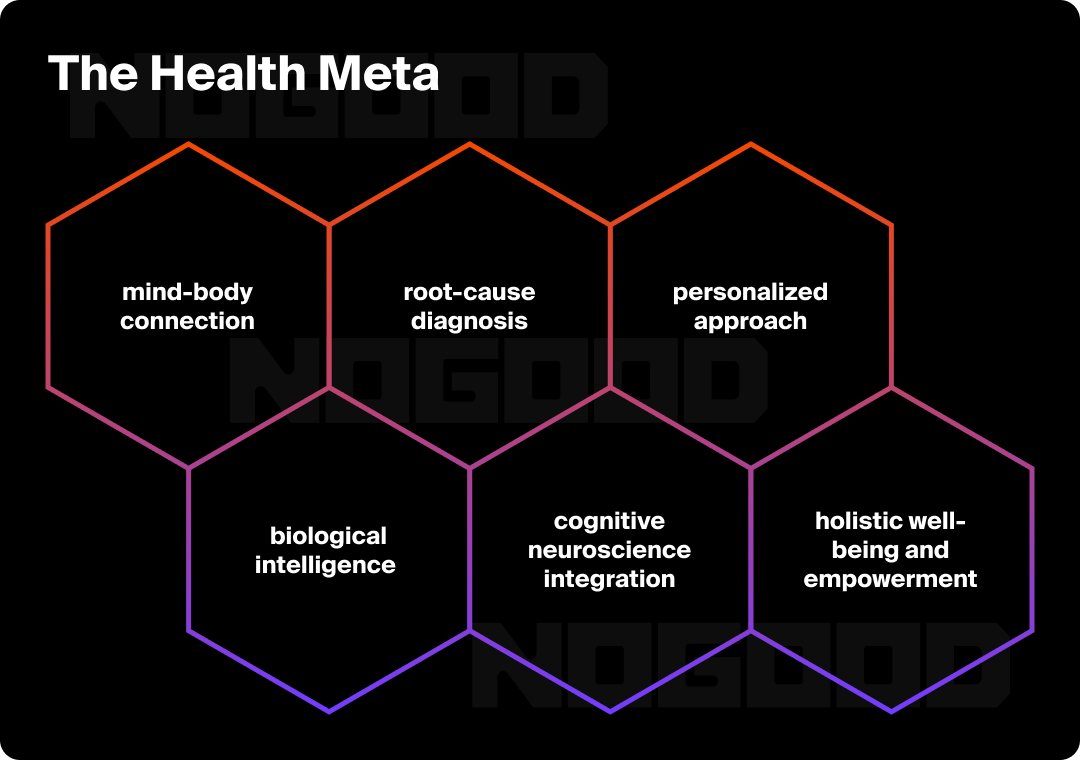
The health meta concept is gaining significant traction in 2025. Health is no longer just a necessity; it’s evolving into a spectrum of lifestyle choices. We’re witnessing:
- Health as a Hobby: For some, health-boosting activities are trendy pursuits, integrated into their lifestyle but not dominating it.
- Health as a Lifestyle: A more extreme mindset, health becomes the cornerstone of existence, encompassing mental, physical, and spiritual well-being.
This spectrum reflects a broader societal shift towards more conscious and diverse approaches to personal wellness.
A massive derivative of the health meta is social health. You’ve likely seen this come to life in the trendy experiences flooding your social media feeds; run clubs, Hyrox competitions, yoga/pilates, pickleball, padel, and five-a-side football. Brands are catching on fast and positioning themselves as facilitators of health as a lifestyle by creating wellness experiences.
The wellness revolution is reshaping brand strategies, with mental health at the forefront. Brands that authentically align with these movements are crafting meaningful connections with consumers. Trust is cultivated via a blend of online initial interplay and real-world interactions.
88% of people state that authenticity is key when deciding which brands to consume and engage with and 78% of consumers (and 88% of Gen Z) agree a brand’s social media presence has a larger impact on whether or not they trust a brand than traditional advertising. Modern consumers prioritize brands that foster genuine relationships across both digital and physical realms, aligning with the elevation of authenticity as an unprecedented importance.
The wellness economy is surging. For example, the city of Miami will be the new home to a $650M luxury development and membership community, built by The Well. Talk about a city with a major cultural and lifestyle shift in the works.
The wellness real estate market is projected to reach $887.5 billion by 2027, according to The Global Wellness Summit. This rapidly expanding sector reflects a growing consumer demand for living spaces that prioritize health and well-being. The Well is a brand wasting no time networking with hospitality partners to capitalize.
As this niche within the economy surges, brands are pivoting from setting goals of product sales to lifestyle creation. It’s about crafting a dynamic, aspirational ethos that resonates with people’s desires and values. Brands that embrace this cultural shift and offer holistic wellness experiences will not only survive but rather, thrive.
Case Studies: Brands Winning at In-Person Fitness Communities
There are several brands that stand out in the market thanks to their increased attention towards physical communities and the health meta.
Red Bull
When you think of Red Bull, what do you visualize? Is it an energy drink? Or is it the F1 race car, cliff jumping diving board, the helmet of a skydiver, the logo on a mountain at the XGames? For me, it’s certainly not the aluminum can. Red Bull’s strategic use of fitness and sporting activations has been instrumental in its transformation from an energy drink company to a global lifestyle brand.

The brand’s intentional approach to in-person activations has allowed them to evolve into a household name and expand credibility universally through the following strategies:
Targeting Niche Sports
Red Bull’s initial focus on extreme sports like motocross, skateboarding, surfing, and BMX in underserved markets brilliantly mirrored the essence of their actual product, an energy drink. By establishing a strong presence in these niche areas, the brand not only built a unique identity but also embodied its promise of “giving you wings” and pushing boundaries. This approach allowed the brand to create an authentic connection between its product and the daring, adrenaline-fueled lifestyle of extreme sports enthusiasts.
Creating Original Events
The company has developed numerous proprietary sporting events, such as the FlugTag, Red Bull Cliff Diving, and Red Bull King of the Air Kiteboarding. These events generate excitement and media attention, reinforcing Red Bull’s association with adventure and pushing limits.
Record-Breaking Initiatives
In 2012, RedBull rewrote the guide for brand marketing when they went to space to beat the longest free fall in history. The brand consistently pushes athletes and inspires others in their community to break records.
Expanding into the Mainstream
Over time, the brand broadened its scope to include more conventional sporting activities such as soccer, basketball, and Formula One racing. The expansion helped increase brand reach and solidify a strong global presence.
Content Creation & Brand Expansion
Rebull’s strategic move to develop into sports allowed them to become a content creator, producing highly shareable, entertaining content around extreme sports and daredevil stunts. This approach transformed the brand’s recognition from a beverage brand into a media conglomerate.
Adapting to Local Markets
From the jump, the brand clearly communicated its goal of establishing a global image. Red Bull went a step further and tailored its sporting activations to resonate with local cultures and preferences in each market they enter. Their “Flugtag” event, meaning “flying day” in German, challenges participants to build homemade, human-powered flying machines and launch them off a pier into the water. This specific sporting activation has since been curated to resonate with other cultures within Singapore, the United States, and Australia.
Red Bull has cracked the code. Their identity transcends its product category by leveraging sporting (fitness) activations to interact with different communities and facilitate social bonding over extreme, jaw-dropping moments. The decision to step outside of product development and into elevating in-person communities has not only made them a household name but has also sold over 10 billion cans annually, generating revenues exceeding $8 billion.This solidifies their position as a global icon in both the beverage industry and the world of sports and entertainment.
While Red Bull pioneered the strategy of leveraging extreme fitness and local cultural events to build a global brand, a new wave of fitness-focused companies is now creating in-person communities to boost brand awareness and tap into the health meta trend. Brands like Bandit Running, Nike, and Alo have been at the forefront of this movement, fostering shared experiences that resonate with health-conscious consumers tapped into the lifestyle.
Bandit Running
Bandit Running, founded in 2020, has quickly become a key player in the running apparel sector by emphasizing their community-first lens. The brand has established a strong presence in New York City, collaborating with local running clubs and hosting fitness events straight out of their retail locations.
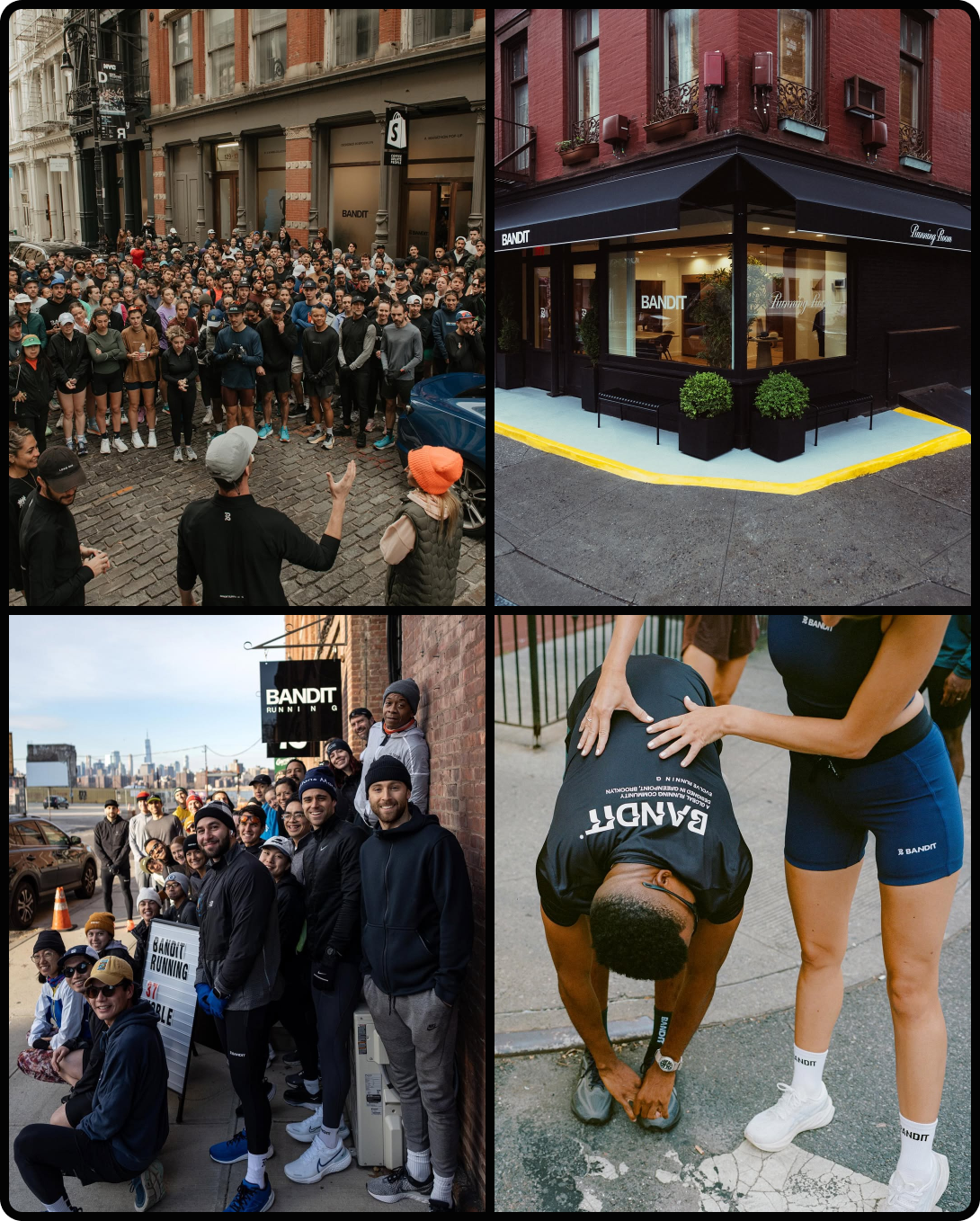
The initial concept centered around changing the visual face of running apparel. Founders Tim and Nick West grew up deep in the New Jersey skater/surfer culture. With their passionate appreciation for brands born out of subculture communities, they wanted to tap into and transform the NYC running subculture, which was spreading like wildfire during the pandemic. They distinguished themselves as a running community built for people with strong ambition, rather than the existing social or performance-based communities. “The Goal-Driven Runner.”
To drive home just how pivotal community is to Bandit, co-founder Nick West stated that community is the product. They built a brand around a community, not a community around an existing brand. Strategies they’ve implemented to expand the community include:
- Highlighting local NYC runners outside of their “runner identity” on social media channels
- Inviting members to their office to capture sentiment and anecdotes about the community
- Producing pop-ups at marathons across the country
- Designing marathon training programs
- Continuing the operation of their original run club in Greenpoint, Brooklyn
- Opened a coffee x runner shop in the West Village of Manhattan
Bandit Running’s unique origin story and ability to 1) identify a community, 2) identify their needs/desires, and 3) elevate the member journey by delivering more impactful, personalized interactions has skyrocketed their brand and further exemplifies how creating shared, in-person experiences can drive brand loyalty and awareness.
Nike
In the same vein, iconic American brand Nike has caught on to the increasing need and desire for in-person communities. In this case, the community they were seeking to entertain needed to sprout from their product-driven brand.
They established Nike Run Club (NRC) to support runners of all fitness levels, including in-person group runs across 40 different cities worldwide. This extension of the brand provides individuals with social connections, participation in global challenges, leadership opportunities, and a chance to chase more achievement in their lives.
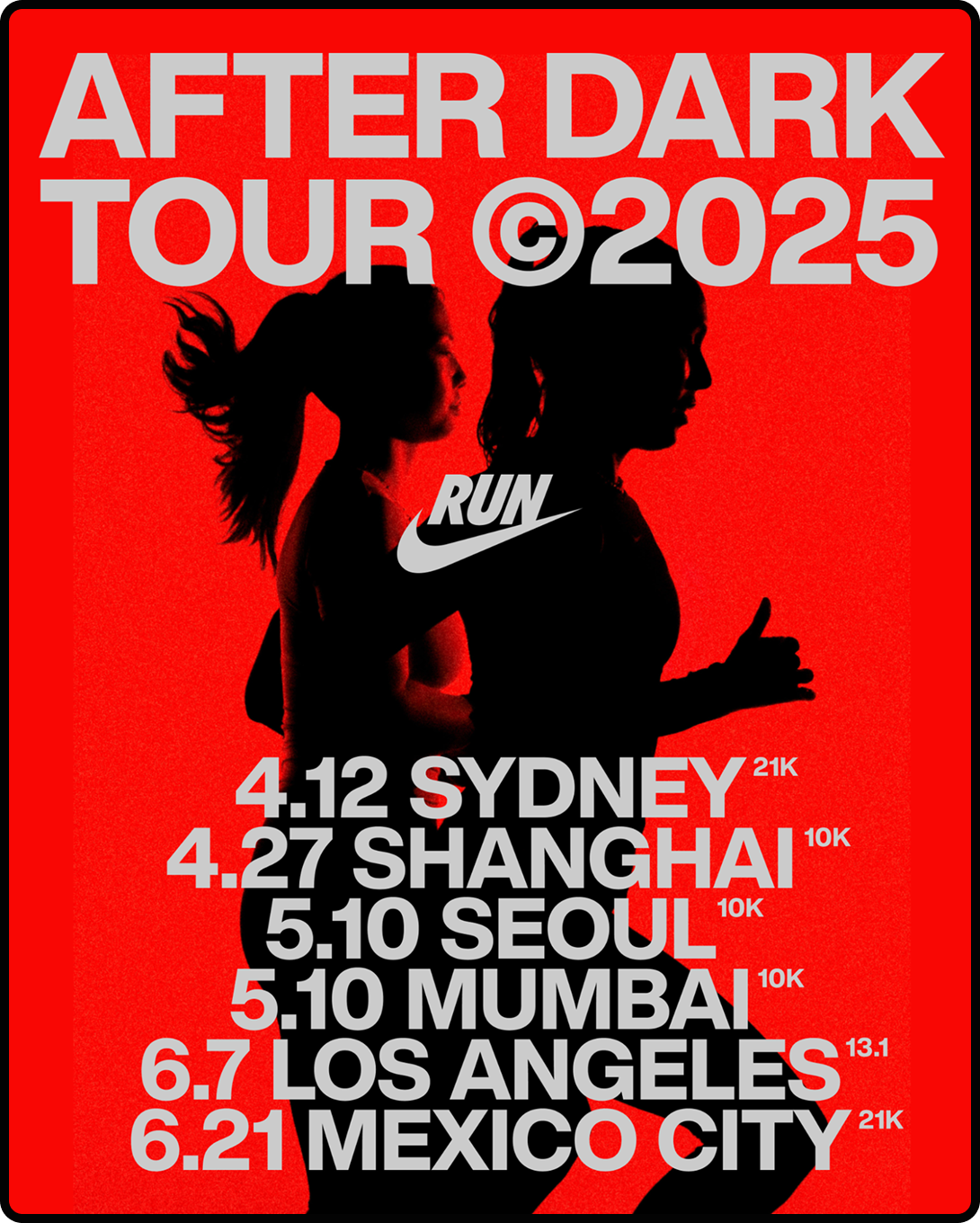
More recently, Nike launched a new 2025 brand strategy, “Nike After Dark Tour,” a women’s nighttime race series. With declining stock and increasing competition blooming with brands like Hoka and On, Nike is attempting to return to their core – athlete storytelling and community engagement.
The tour empowers women through strategic nighttime running events in major cities worldwide. This innovative series addresses a universal concern among female runners: safety after dark. By creating a secure, vibrant environment for nocturnal runs, Nike not only tackles a pervasive issue but also facilitates a powerful sense of community among female athletes. The tour transforms a common fear into an exhilarating, shared experience, blending fitness, in-person community, and female empowerment.
Additional Brand Examples of Successful Community Events
Nike’s approach aligns with the broader health meta trend, where brands are creating multi-faceted, experiential in-person spaces to engage consumers. In the above case study, Bandit’s NYC flagship exemplifies this by combining a run club, coffee shop, and retail store all into one.
On Running has embraced this strategy as well with their Track Nights, merging athletic competition with festival-like atmospheres. Lululemon has stepped up too, adopting this approach by organizing an ultramarathon fostering community among female runners to push their boundaries.
Similar to Red Bull in the beverage product-space, Michelob ULTRA, an alcoholic beverage brand, tapped in as well. The brand launched an in-person and digital unique event series that combines boxing workouts with live music performances. Their “Boxing Experience Tour” took place across multiple cities in the U.S. and appealed to those looking to create social connections and experience a unique community in real life.
What Not to Do: Alo Yoga
However, not all brands stepping into the game of community building are finding success. Within the last few years, Alo Yoga applied significant pressure to their marketing efforts to drive home their well-known exclusivity and luxury positioning. The main pursuit out of this shift was their “Alo Yoga Studio.” In an attempt to build unique collaborations and community with high-profile celebrities and social media influencers, the “invite only” exclusive gym concept inadvertently created promotion of elitism.
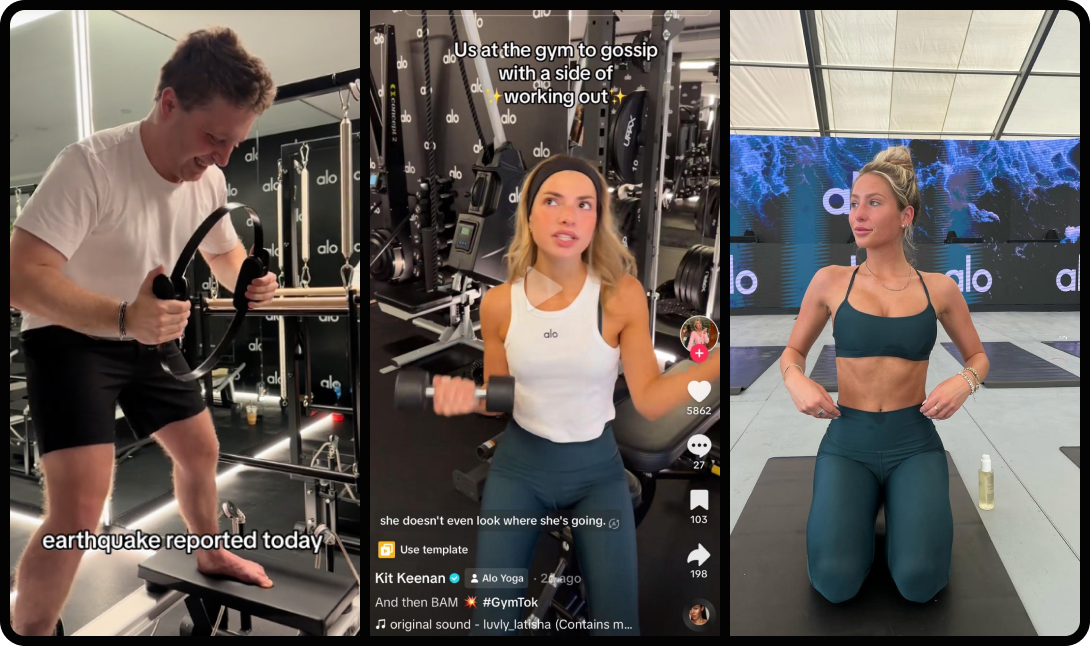
The major miss of this strategy is that GenZ demands relatability. This rising generation in the marketplace is demanding authenticity, inclusion, and connection. By prioritizing exclusivity over inclusivity, Alo Yoga squandered a transformative opportunity to democratize wellness and build a truly expansive fitness in-person community.
Overall, we’re seeing a larger shift toward immersive brand experiences, and the brands that are succeeding understand that modern consumers seek more than just products – they crave authentic connections, shared experiences, and a sense of belonging within a community of like-minded individuals.
Technology’s Role in Building Fitness Communities
Wearable technology, AI agents, and mobile apps are optimizing the membership experiences of physical communities and creating engaging, personalized, and socially connected fitness experiences.
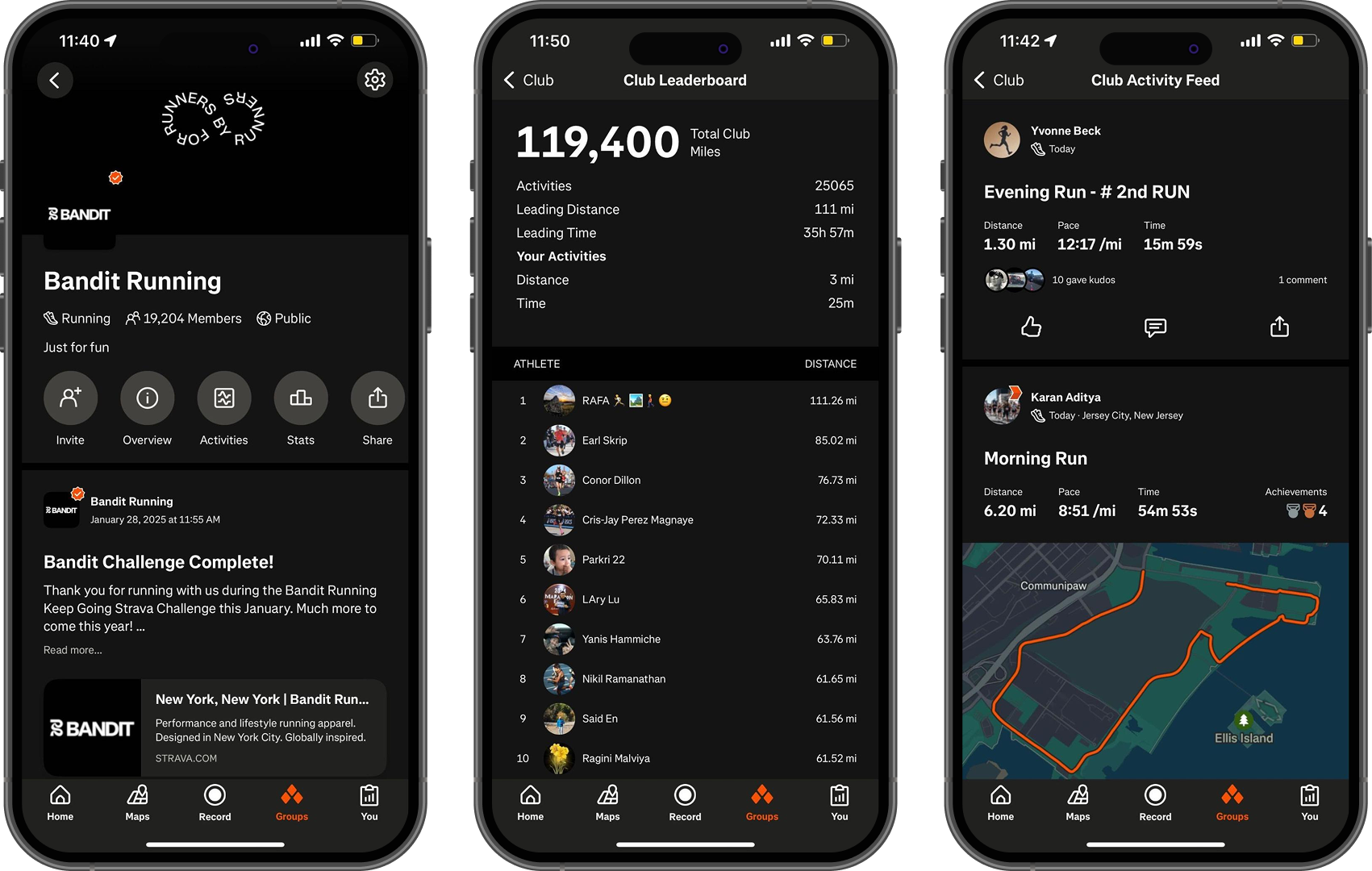
Technologies like Strava empower fitness-focused communities by enabling progress tracking, achievement sharing, and friendly competitions, which allows a brand to encourage accountability and connection between brand community members.
Brands like Bandit Running leverage Strava’s user-friendly interface to create “Clubs,” digital spaces that act as an extension of the previously created, in-person community connections. These branded “Clubs” help support easy member recruitment, showcase real-time community activities in a feed, lifetime community stats, and host ongoing fitness challenges.
Some brands have the opportunity to imbed social connectivity into their modern health and fitness tech, with community-driven features to transform individual wellness journeys into collective experiences. For instance, Oura Ring introduced “Circles” in 2023, allowing users to share their daily Readiness, Sleep, and Activity scores with up to 20 friends in customizable groups.
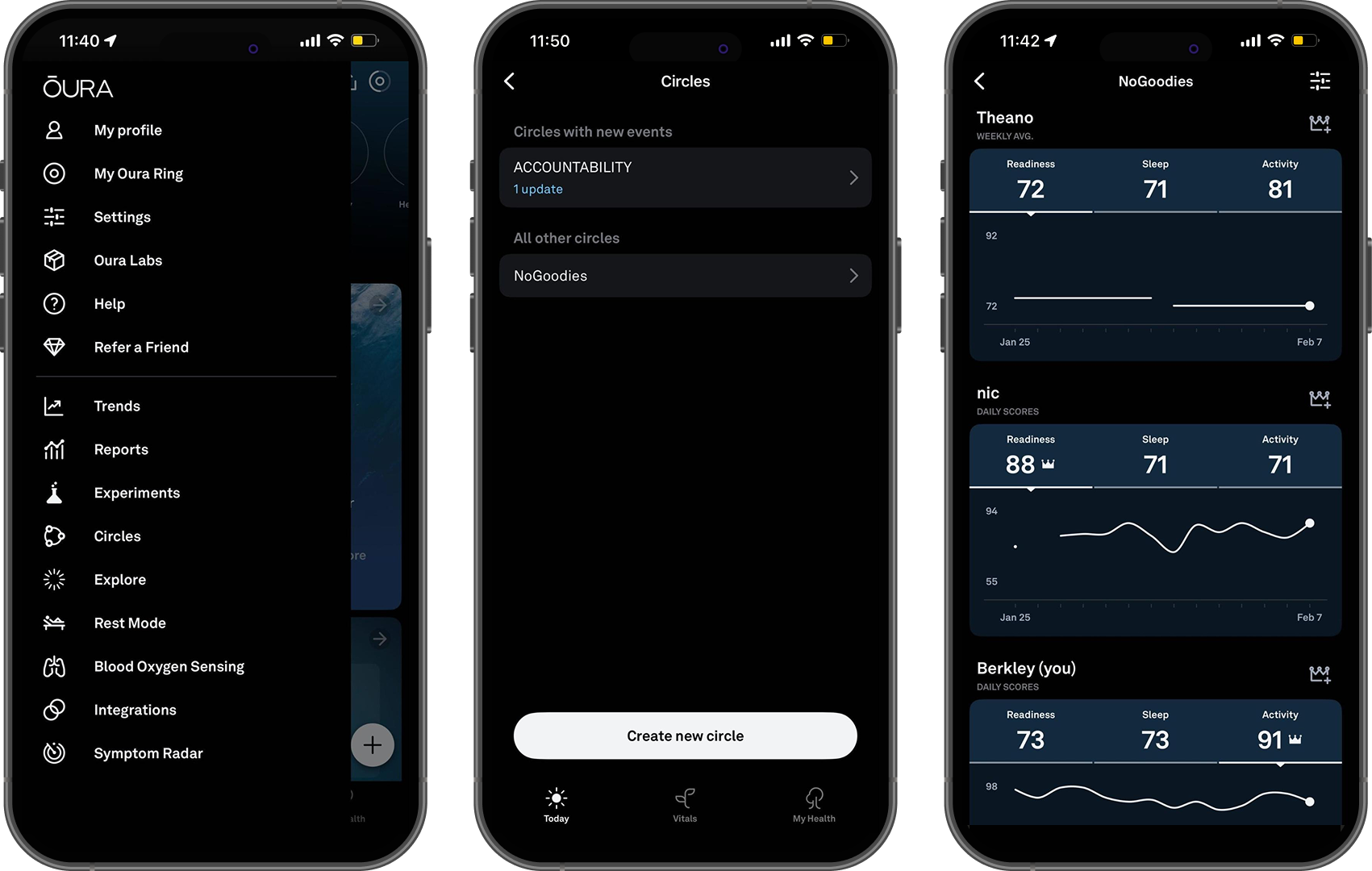
Similarly, Apple Watch users can share their activity data and workouts with friends, encouraging friendly competition and accountability. Other fitness apps like Freeletics and Peloton have also incorporated robust social connectivity features, including community feeds, training groups, and the ability to send virtual encouragement.
These social elements not only enhance user engagement but also drive home the brand’s attention to crafting community and support. These strategic moves transform solitary fitness routines into shared experiences that keep users motivated for more.
Technology should enhance, not replace, your brand’s community — serving as a dynamic extension of the physical connection and shared experiences of members. By integrating tech into the strategy, brands can create more meaningful, accessible, and engaging community interactions that transcend the traditional boundaries.
Measuring Success and Scaling Your Community
76% of consumers wish their favorite brands had a community. This should signal to brands that they have a massive opportunity to meet consumer desires and differentiate themselves in the market via an extension of the brand. By creating genuine, in-person communities, brands can tap into this unmet need, acting as a bridge for deeper connections and potentially gaining competitive edge. However, building a community is just the first step; measuring its impact is crucial for ongoing success and optimization.
Here are five key performance indicators (KPIs) to consider when evaluating the success of your branded, in-person community:
- Membership Retention Rate: This measures the percentage of members who remain active over a given period, indicating customer satisfaction and investment in the community.
- Average Activation Attendance: Tracking attendance for in-person activations, whether it’s a run, fund-raising event or challenge. This helps gauge member engagement and the popularity of different offerings.
- Net Promoter Score (NPS): This metric measures member satisfaction and loyalty, indicating how likely members are recommending your fitness community to others.
- Community Satisfaction Scores: Regular surveys can assess members’ sense of belonging, satisfaction with the community, and overall experience.
- Conversion Rate from Membership to Additional Services: This measures how effectively the community drives sales of the brand’s OG products or services.
As brands navigate building in-person, fitness/wellness communities to drive further brand investment, they need to consider 1) the delicate balance between creating intimate yet inclusive experiences, 2) technology emerging as a powerful ally in enhancing these shared experiences, and 3) the accelerating trend that is the Health Meta and how physical experiences where wellness and fitness is top priority have a psychological and social force that inspires further brand growth and loyalty.





